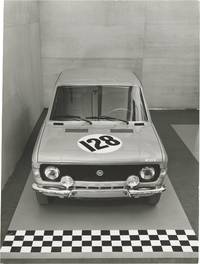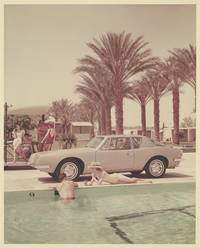1975 · San Diego, CA
by [Fast Food] [Automobile Culture]
San Diego, CA: Jack in the Box, Inc, 1975. Archive of ten original marker and pencil concept illustrations for the Jack in the Box restaurant drive-thru ordering station and two-way intercom system, 1975. Nine of the illustrations are signed by the designer and dated June 30, 1975 in the lower right corner, with eight of the illustrations mounted to illustration boards.
The first use of a two-way intercom at a fast-food restaurant drive-in is credited to In-N-Out Burger founder, Harry Snyder, in 1948, which allowed customers to place and receive orders without leaving their car or the need of a carhop. Robert O. Peterson, founder of Jack in the Box restaurants, embraced the concept when opening the first Jack in the Box in San Diego in 1951, and insisted all future franchisees incorporate the ordering system, helping to make drive-thrus a staple in fast-food chains from the 1960s onward.
Since its founding in 1951, Jack in the Box has become one of the most iconic, and lucrative, fast-food restaurants in the US. Largely based on the West Coast, the franchise grew to 24 restaurants in 1961 and to 870 by the end of the 1960s. After being purchased by the Ralston Purina Company in 1968, Jack in the Box began expanding throughout the Midwest and Northeast throughout the 1970s. By the 1980s the company began closing its Northeast stores to focus on its more successful West Coast restaurants. Today the chain has over 2,200 locations, with nearly half of its locations in California with most of the remaining restaurants in Oregon, Washington, Arizona, and Texas.
The ten concept illustrations found in the collection here were made in 1975, a time of unprecedented growth for the company, when the iconic Jack in the Box clown, perched atop its restaurants and drive-thru stations, was becoming ubiquitous across the national fast-food landscape. Offered here are scarce internal designs presenting variations on the standard back-lit glass menu signs with two-way intercom systems which were becoming omnipresent at fast-food restaurant drive-thrus by the mid-1970s.
Among the novel designs for the ordering stations are:
Static painted panels designed to light up behind the appropriate prompt (i.e.; "please order now," "repeat order," and "thank you").
Multi-panels designed to light the panel with the appropriate prompt.
A circular "carousel" design which rotates to the appropriate prompt.
Prompts on a film which rotate, back-lit with a fluorescent light, within an ordering station with a two-way intercom, and an LED sign incorporated into the base.
And a futuristic design incorporating a video monitor adjacent to a two-way intercom.
12 x 9 inches. Near Fine. (Inventory #: 163807)
The first use of a two-way intercom at a fast-food restaurant drive-in is credited to In-N-Out Burger founder, Harry Snyder, in 1948, which allowed customers to place and receive orders without leaving their car or the need of a carhop. Robert O. Peterson, founder of Jack in the Box restaurants, embraced the concept when opening the first Jack in the Box in San Diego in 1951, and insisted all future franchisees incorporate the ordering system, helping to make drive-thrus a staple in fast-food chains from the 1960s onward.
Since its founding in 1951, Jack in the Box has become one of the most iconic, and lucrative, fast-food restaurants in the US. Largely based on the West Coast, the franchise grew to 24 restaurants in 1961 and to 870 by the end of the 1960s. After being purchased by the Ralston Purina Company in 1968, Jack in the Box began expanding throughout the Midwest and Northeast throughout the 1970s. By the 1980s the company began closing its Northeast stores to focus on its more successful West Coast restaurants. Today the chain has over 2,200 locations, with nearly half of its locations in California with most of the remaining restaurants in Oregon, Washington, Arizona, and Texas.
The ten concept illustrations found in the collection here were made in 1975, a time of unprecedented growth for the company, when the iconic Jack in the Box clown, perched atop its restaurants and drive-thru stations, was becoming ubiquitous across the national fast-food landscape. Offered here are scarce internal designs presenting variations on the standard back-lit glass menu signs with two-way intercom systems which were becoming omnipresent at fast-food restaurant drive-thrus by the mid-1970s.
Among the novel designs for the ordering stations are:
Static painted panels designed to light up behind the appropriate prompt (i.e.; "please order now," "repeat order," and "thank you").
Multi-panels designed to light the panel with the appropriate prompt.
A circular "carousel" design which rotates to the appropriate prompt.
Prompts on a film which rotate, back-lit with a fluorescent light, within an ordering station with a two-way intercom, and an LED sign incorporated into the base.
And a futuristic design incorporating a video monitor adjacent to a two-way intercom.
12 x 9 inches. Near Fine. (Inventory #: 163807)












